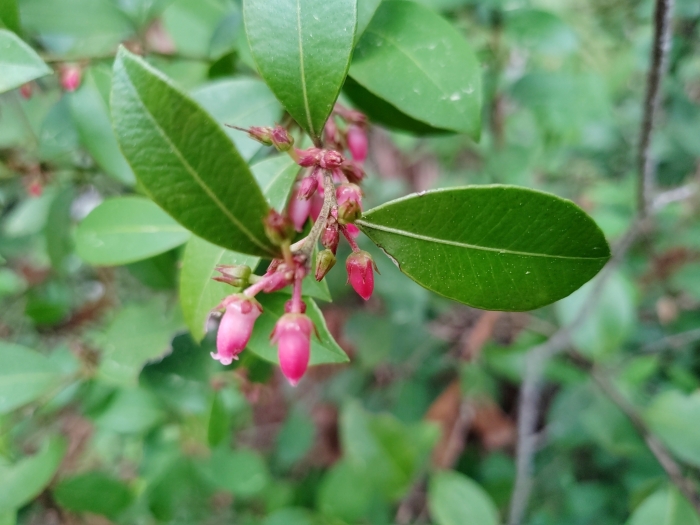Fetterbush Lyonia
(Lyonia lucida)
Fetterbush Lyonia (Lyonia lucida)
/
/

By Lauren Gillett no rights reserved
Public Domain
Image By:
By Lauren Gillett no rights reserved
Recorded By:
Copyright:
Public Domain
Copyright Notice:
Photo by: By Lauren Gillett no rights reserved | License Type: Public Domain | License URL: http://creativecommons.org/publicdomain/zero/1.0/ | Uploader: igotflowerpower | Publisher: iNaturalist |




















































Estimated Native Range
Summary
Lyonia lucida, commonly known as Fetterbush Lyonia, is an evergreen shrub native to the understory of pine flatwoods, bogs, and savannas in the Southeastern USA, particularly in Florida and Georgia. It can reach 4 to 5 meters in height and spread, often forming dense thickets due to its long rhizomes that sprout new plants. The plant’s leathery leaves are glossy and alternately arranged on scaly twigs, contributing to its ornamental value. From late winter to early spring, Fetterbush Lyonia produces showy clusters of bell-shaped flowers that are typically pink, although they can also be white or red, followed by inconspicuous dry capsules as fruit.
Fetterbush Lyonia is valued for its year-round foliage and spring floral display, making it a popular choice for naturalistic plantings, wetland restoration, and as an understory shrub in woodland gardens. It is adaptable to a range of light conditions, from full sun to part shade, and can tolerate various soil types, including those with poor nutrients. However, it thrives best in acidic, well-drained soils and requires consistent moisture. While it is generally low-maintenance, it can be susceptible to leaf spot diseases and may require pruning to control its spread. This plant is not known for aggressive roots or significant pest problems. It is not typically invasive when grown outside its native range but should be monitored to prevent unwanted spread.CC BY-SA 4.0
Fetterbush Lyonia is valued for its year-round foliage and spring floral display, making it a popular choice for naturalistic plantings, wetland restoration, and as an understory shrub in woodland gardens. It is adaptable to a range of light conditions, from full sun to part shade, and can tolerate various soil types, including those with poor nutrients. However, it thrives best in acidic, well-drained soils and requires consistent moisture. While it is generally low-maintenance, it can be susceptible to leaf spot diseases and may require pruning to control its spread. This plant is not known for aggressive roots or significant pest problems. It is not typically invasive when grown outside its native range but should be monitored to prevent unwanted spread.CC BY-SA 4.0
Plant Description
- Plant Type: Shrub
- Height: 3-6 feet
- Width: 3-6 feet
- Growth Rate: Moderate
- Flower Color: Pink, White
- Flowering Season: Spring
- Leaf Retention: Evergreen
Growth Requirements
- Sun: Full Sun, Part Shade
- Water: Medium
- Drainage: Fast, Medium, Slow
Common Uses
Bee Garden, Bird Garden, Butterfly Garden, Deer Resistant, Erosion Control, Fire Resistant, Fragrant, Groundcover, Showy Flowers, Water Garden
Natural Habitat
Native to the understory of pine flatwoods, bogs, and savannas in the Southeastern USA
Other Names
Common Names: Shinyleaf, Shining Fetterbush, Hurrahbush, Staggerbush, Fetter Bush
Scientific Names: , Lyonia lucida, Andromeda nitida, Andromeda mariana, Pieris nitida, Lyonia nitida, Andromeda coriacea, Andromeda lacustris, Leucothoe coriacea, Desmothamnus lucidus
GBIF Accepted Name: Lyonia lucida (Lam.) C.Koch